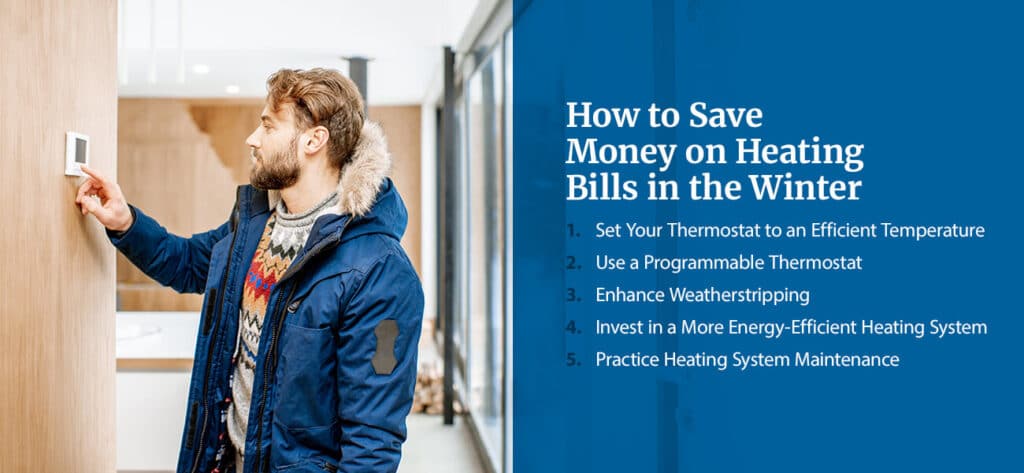
Finding an indoor temperature that keeps everyone warm and comfortable in the winter can be tricky. It’s essential to find some middle ground when settling on heating temperatures in winter. Selecting the optimal temperature can keep your family and home warm, protect your pipes from freezing and help you save money on your utility bill all at once.
What is a reasonable temperature for a house in the winter? Continue reading to discover the most reasonable temperatures for your thermostat in the winter.
Recommended Thermostat Settings for Winter
Finding the right thermostat temperature in winter can be tricky. Everyone feels hot and cold at different times and may prefer varying temperature settings. While some people stick to one optimal temperature in the winter, others change their thermostat settings throughout the day.
The Department of Energy recommends 68 degrees Fahrenheit as a reasonable temperature for your house in the winter during the day to keep you comfortable and ensure your pipes don’t freeze. Lowering the temperature by seven to 10 degrees for eight hours a day can also help you save energy, so set your thermostat below 68 degrees Fahrenheit when you’re not at home and when you’re asleep at night.
What Is a Reasonable Temperature for a House in the Winter at Night?
A reasonable thermostat temperature to set your house at during the nighttime is between 65 to 69 degrees Fahrenheit. While It’s normal to want your home to be warmer in the evening, lowering your temperature can help you sleep better — temperatures that are too hot or cold can affect your sleep quality. If you’re concerned about getting too cold at night, wear warm pajamas and layer your bed with thick blankets to keep cozy.
Does Lowering the Heat at Night Save Money?
Gradually lowering your heat by seven to 10 degrees every day can save your household 10% on your heating bill annually. Reducing the thermostat progressively can make it more efficient to reheat your home when you wake up. As a result, you save money because your house remains at cooler temperatures for longer.
What Temperature in the Winter Is Best to Save Money?
Setting your thermostat to 55 degrees Fahrenheit is one of the best ways to save money in winter. While 55 degrees can seem icy, it’s one of the most efficient temperatures for your house in the winter when you’re not home. Keeping your home cooler when you’re not there and gradually increasing the temperature as you get home can be one of the best ways to save money on energy bills in the winter.
Does Turning the Heat on and Off Raise Your Utility Bill?
Turning your heat off at home doesn’t raise your utility bills. Leaving your heat at the same setting and running it all day requires more energy and can cost you more. You can turn your heat off when you leave your house and gradually turn it on when you get home to save energy.
If you have a programmable thermostat, set the temperature to increase and decrease at certain times for maximum comfort and energy savings.

How to Save Money on Heating Bills in the Winter
There are many ways to save money on your heating bills in addition to setting your temperature appropriately. Here are some cost-effective heating tips for winter:
1. Set Your Thermostat to an Efficient Temperature
As stated, setting your thermostat’s temperature to 68 degrees Fahrenheit can keep your home warm and save you money on energy bills at the same time. You can gradually turn down the temperature as everyone starts acclimating to the slightly cooler temperatures. Wearing warmer pajamas and using blankets in the evening can help you and your family keep warm and allow you to lower your thermostat comfortably throughout the evening.
2. Use a Programmable Thermostat
Investing in a programmable thermostat can help you save time and energy. You can set your thermostat to increase and lower the heat at various times of the day, saving you a lot of time and effort. With a programmable thermostat, you can preset your temperatures in the morning, preventing you from forgetting to adjust your settings.
It’s best practice to program your thermostat to a lower temperature whenever your household is away from home, such as during the day when everyone is at work or school. Then, when your family starts to arrive back home toward the end of the day, the thermostat should adjust to a warmer temperature.
3. Enhance Weatherstripping
Before turning up the heat in the winter, ensure your home is free of drafts. Your heating system can heat your home more effectively without any drafts from windows and doors. Weatherstrip your windows, doors and other areas where cold air might enter your home.
4. Invest in a More Energy-Efficient Heating System
New heating systems come with advanced settings and mechanisms that help you save energy and bills. An older furnace may take longer to heat up and be less efficient. Consider investing in a new furnace before winter begins if yours is several years old or needs extensive repair.
5. Practice Heating System Maintenance
Summer can be the perfect time to schedule professional furnace maintenance and tune-up. A well-maintained furnace can work more efficiently and reduce the chances of any issues in the winter. Ensure your heating systems work well before the cold weather comes around to save energy and money on maintenance in the winter.

Save on Your Energy Bills With Marstellar Oil and Concrete
Selecting a cost-effective home heating oil for your furnace is another point to consider when heating your home in the winter. Marstellar Oil and Concrete offers reliable heating oil for your air or water-based furnace. Our lowest minimum and fast delivery can help you save money this winter. We provide a quick online heating oil ordering process so that you can order your oil when you need it and save time and money.
Contact us with questions or order heating oil online today!


